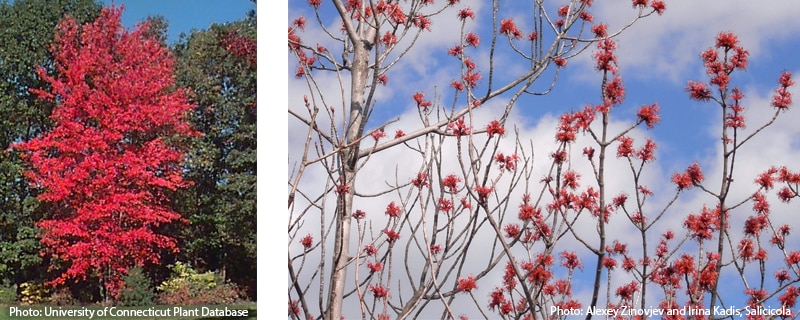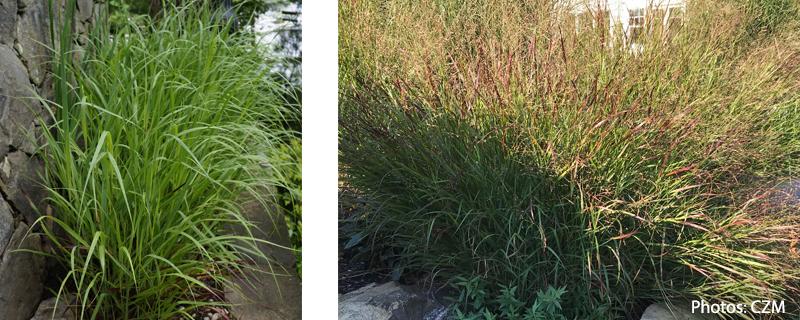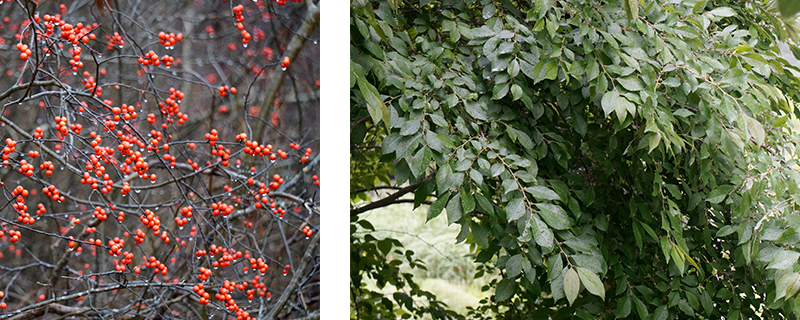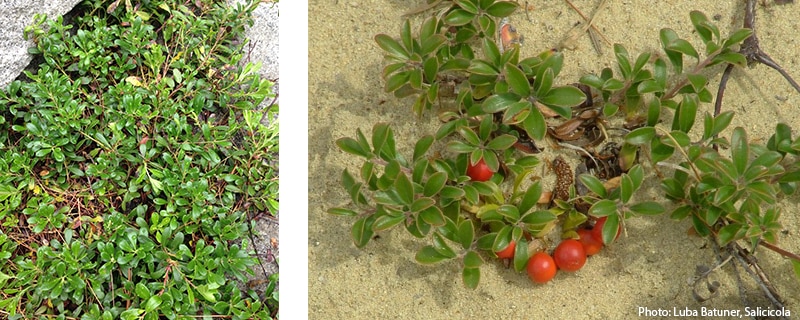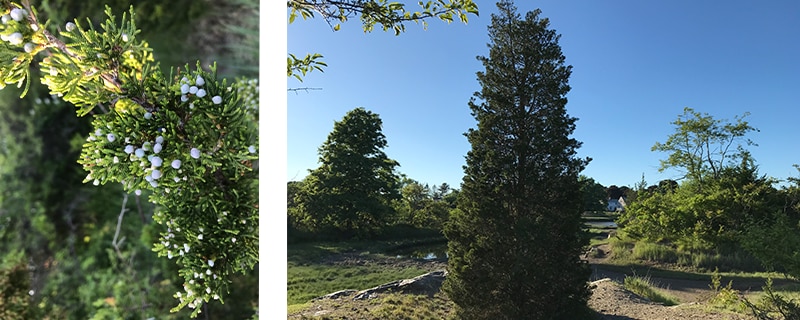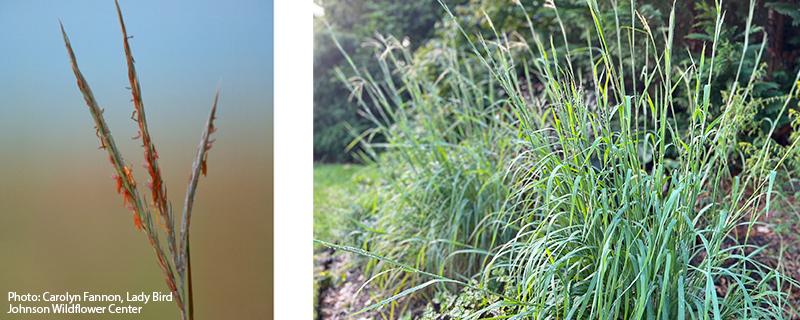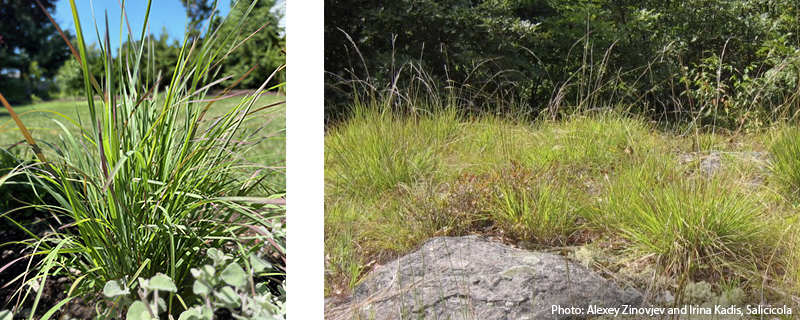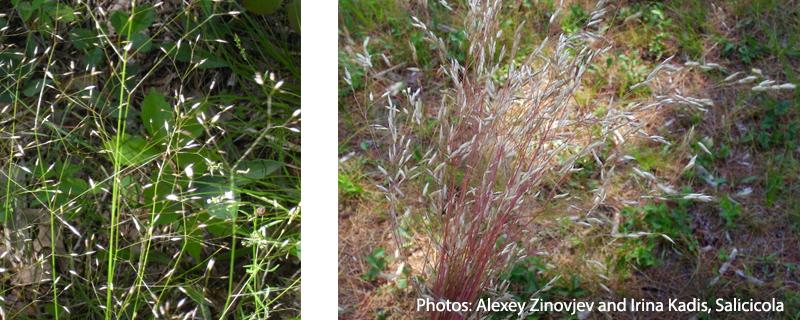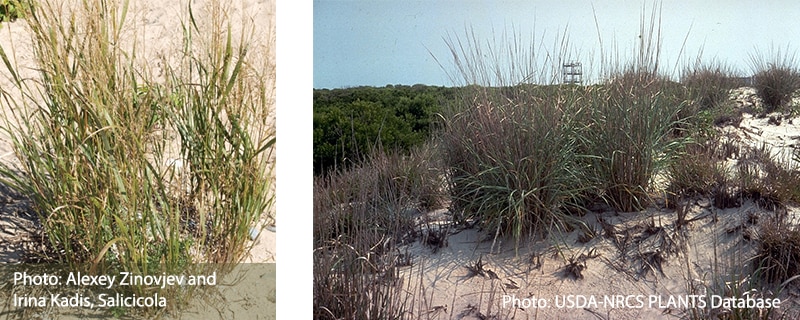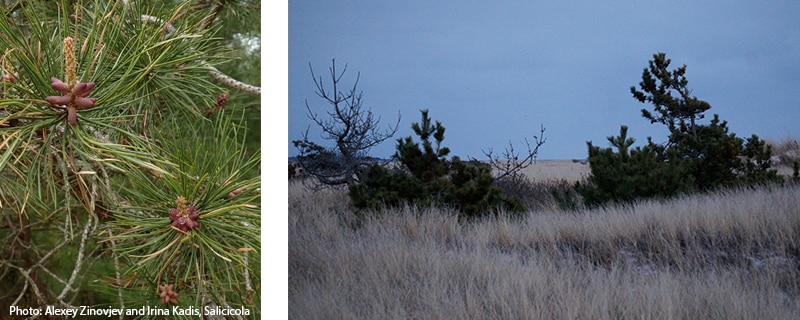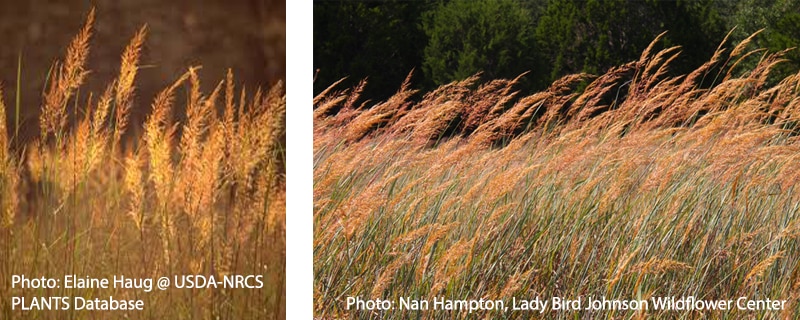Gardens are never static. Constantly changing and transitory in nature, they offer various forms of beauty throughout the seasons. As summer fades and the sun falls lower in the sky, the foliage dies, the leaves and stems turn a russet color, and the flowers go to seed. But plants can be quite beautiful in death, evoking many moods and emotions as they transform. Think of how the low autumn light shimmers off the clustering flower heads of fading perennials and warmly illuminates the lingering straw-colored stems of tall grasses. Think of the brilliant colors and rustling sounds of deciduous tree leaves stirring up a sense of nostalgia for time passing. Think of the first frost covering the remaining plants and transforming the landscape into a scene of cool tranquility. By planting trees, shrubs, perennials, and grasses that offer beautiful color, texture, light, form, and movement, you can create a dynamic character and mood to your coastal garden throughout the year. The plants listed below are all native to Massachusetts and were specifically selected for their capacity to endure the conditions at coastal sites (but most are suitable for inland sites too). When choosing a plant, please check its growing requirements to make sure it will thrive in the temperature, soil, light, and water conditions of your yard.
For photos and additional information for many of the plant species listed below, see Coastal Landscaping in Massachusetts - Plant Highlights and Images.
Warm Colors
Though the colors of fall and winter are not as diverse as those of the spring and summer, the low-angled sunlight beautifully highlights the colors that do dominate the landscape. The warm red, orange, and golden shades of autumn leaves are particularly effective at intercepting this low-angled light and creating an appealing glow. The bright-colored berries, seed heads, and stems of other plants that remain through fall and winter provide a striking contrast to the cool and cold elements of those seasons. You can maximize this effect in your own garden by planting particular trees, shrubs, grasses, and perennials that are renowned for their colorful displays. The following plants offer warm fall and winter colors:
- Red Maple (Acer rubrum) - One of the first bursts of autumn color—red maple leaves range from bright yellow-green to vibrant scarlet to rich burgundy. The leaf buds and even the stems and twigs of this maple are often red, making it a colorful focal point throughout the year.
- Red Osier Dogwood (Cornus sericea) - This woody, deciduous shrub has smooth bark and twigs that turn a deep red to purple in the fall and remain a colorful attraction through winter into spring. (It is best planted away from exposure to wind and salt spray.)
- Switchgrass (Panicum virgatum) - This clump-forming grass has open, lacy sprays with small reddish-purple seeds that turn pale yellow. The spring and summer green leaves, which grow along the stem, turn bright yellow in the fall. Some cultivars provide even more striking colors, such as metallic blue and ruby red, throughout the year.
- Winterberry (Ilex verticillata) - Densely packed, red berries are the hallmark of this deciduous, multi-stemmed shrub. The bright berries on bare stems, which remain throughout the winter (unless eaten by hungry birds!), provide an attractive fall and winter display.
Ever-Greens
During the spring and summer months, green foliage is all around us—verdant, lush, and encompassing the majority of the landscape canvas. However, in the fall and winter, green becomes more of a focal point due to its relative scarcity. Planting evergreen trees, shrubs, and groundcovers can give you an enduring contrast to the earth tones that dominate the fall and winter landscape. Various evergreens can also act as a hedge and/or wind barrier, provide structure and form to fill an otherwise barren landscape, and effectively catch and drape freshly fallen snow. In addition, evergreen trees and shrubs provide valuable cover for birds, and their twigs, leaves, and seeds offer important wildlife food. For an ever-green and diverse landscape, try the following plants:
- Bearberry (Arctostaphylos uva-ursi) - In the fall, the leathery, dark leaves of this low-growing shrub turn reddish purple, and the white-pink flowers transform into bright red berries. The dense growing habit, evergreen leaves, summer flowers, and fall berries that persist into winter make this groundcover/shrub an attractive year-round accent.
- Creeping Juniper (Juniperus horzontalis) - This dense, spreading, low-growing evergreen shrub has long, trailing branches covered with blue-green, scale-like foliage that is soft when mature. Dark blue, berry-like cones persist through winter. Many wildlife species feed on and find cover in creeping juniper.
- Eastern Red Cedar (Juniperus virginiana) - This large evergreen tree has dark-green needles that have a bronze cast during the cold months and attractive, berry-like blue cones that ripen from September through October. Eastern red cedar is excellent as a specimen planting and useful in masses for windbreaks and screening.
- White Spruce (Picea glauca) - A broadly conical to spire-like form with slightly drooping horizontal branches marks this evergreen tree. The needles are blue-green and the seed cones turn from a light green to a light brown at maturity. White spruce provides an important food source and cover for many wildlife species and helps to stabilize soil.
Texture, Form, and Light
Grasses have become quite popular in the landscape for good reason—they are reliable, have a long season of interest, and can tolerate a wide range of environments, including harsh coastal conditions. Much of their interest lies in their unique textures, their graceful arching forms, and the way they catch the light with their feathery plumes. In addition, the stems and seed heads that persist through the winter provide visual interest year round. Their form and texture, in combination with light and wind, can offer a visual impression of a more naturalistic garden, elegant but less fussy. Grasses also provide bountiful seeds for wildlife and stabilize soils with their deep, fibrous roots. The following are a few grasses that are hardy enough for the coast while offering attractive texture and form to the fall and winter landscape:
- Big Bluestem (Andropogon gerardii) - The unique features of this clump-forming grass are its large upright stature, interesting flower and seed heads that resemble a turkey's foot, and leaves that emerge gray to blue green in spring, mature to green with red tinges in summer, and turn reddish bronze with lavender tones in autumn after a frost.
- Little Bluestem (Schizachyrium scoparium) - This mound-forming grass has fine-textured foliage and slender stems that turn a mahogany red after a frost and are tipped with white cottony seed heads that catch the light and provide visual interest through the winter.
- Prairie Dropseed (Sporobolus heterolepis) - A fine-textured, clumping grass, prairie dropseed has thin, arching, green blades that turn golden orange in the fall and open and airy flowers in shades of pink and tan. This grass, with its graceful fountain-like form, is extremely effective as an accent plant or in mass plantings. (It is best planted away from direct exposure to wind and salt-spray.)
- Wavy Hairgrass (Deschampsia flexuosa) - This fine-textured grass has delicate, spray-like flower heads on wavy, hair-like evergreen stems. The soft texture and tiny seed heads respond well to low-angled light and look especially ethereal when backlit.
Movement
Gardens grown on the coast are subject to the whims of the wind. And while the sea breeze can be detrimental to many plants, it can be a positive influence on others. Particular grasses and perennials respond to and move fluidly with the winds, while various shrubs and trees withstand the battering effect to flourish with an expressive and interesting growth habit. If you would like to maximize the effects of the sea breeze in your garden, try planting:
- Bugbane (Cimicifuga racemosa) - This tall perennial has airy spikes of ivory flowers that turn to seed heads and remain a focal point well into the fall. Its height and architectural stature make it an imposing force in the garden that looks particularly attractive when blowing in the wind. (It is best planted in moist, heavy soil and away from direct exposure to wind and salt spray.)
- Coastal Panic Grass (Panicum amarum var. amarulum) - Mass plantings of this tall, fountain-like grass with attractive, powder-blue foliage can highlight the effect of the wind moving across the landscape. Its blue-tinged flowers bloom through late fall and are followed by beige seed heads that persist well into winter.
- Pitch Pine (Pinus rigida) - This hardy, dark-evergreen tree grows well under harsh coastal conditions. In response to the wind, this pine can grow with an open and often picturesque habit and form, giving the appearance of full-size Bonsai trees that are meticulously pruned and shaped.
- Yellow Plume Grass (Sorghastrum nutans) - In the fall, the slender, blue-green leaves of this hardy upright grass turn yellow and the towering stiff stems topped with narrow, plume-like auburn flower heads turn deep orange or purple. Because of its vertical form and height, it sways easily at the slightest breeze.
Additional Resources
Looking for more plants for your coastal garden? Visit these websites to find additional information:
- Coastal Landscaping - This Massachusetts Office of Coastal Zone Management (CZM) website provides information on the benefits of landscaping coastal property with native, hardy, salt-tolerant plant species for the primary purposes of providing storm damage prevention and erosion control. The site includes plant lists, sample landscape plans, and photographs and detailed information on particular plant species.
- American Beauties - In collaboration with the National Wildlife Federation's Backyard Wildlife Habitat Program, this site provides a list of native plants species, descriptions, and landscape plans for four theme gardens (bird garden, butterfly garden, dry sun, and moist sun) that are beautiful and good for wildlife. The website also provides information on where to purchase native plants in your area.
- Blue Stem Natives - This site provides descriptions of native plants, which can be searched for by interest (such as sustainability, wildlife, and beauty), targeted areas (such as shorelines and roadsides), or plant attribute (such as size, height, plant spacing, bloom time, and sun and water needs). The site also includes native plant resources, videos, a blog, and landscape design help.
- Cape Cod Native Plants - This online tool hosted by Association to Preserve Cape Cod (APCC) is designed to help gardeners on Cape Cod find native plants suited for specific sites and that complement their landscape design. Users can search for plants based on plant type, sunlight, soils, bloom month, size, and nature benefits. As part of their Native Plant Initiative, APCC also provides helpful resources, such as native garden design examples, Sources for Native Plants & Seeds (PDF, 134 KB), a List of Resources About Native Plants (PDF, 88 KB), and Recommended Presentations on landscaping with native plants (PDF, 104 KB).
- PLANTS Database - From the United States Department of Agriculture (USDA) Natural Resources Conservation Service (NRCS), this database provides plant descriptions, characteristics and classification, distribution, and images.
- University of Connecticut (UConn) Plant Database of Trees, Shrubs, and Vines - This site provides specifics on plant attributes—such as habitat, form, seasonal characteristics, culture, and landscape uses—accompanied by images.
- Connecticut Native Plant and Sustainable Landscaping Guide (PDF, 114 MB) - From the University of Connecticut Extension Program, this guide provides comprehensive lists, descriptions, and photos of native plants (for Connecticut), including native forbs that grow easily from seed, native perennials for garden beds or rain gardens, low-growing ground covers, salt tolerant and coastal plants, and much more.
